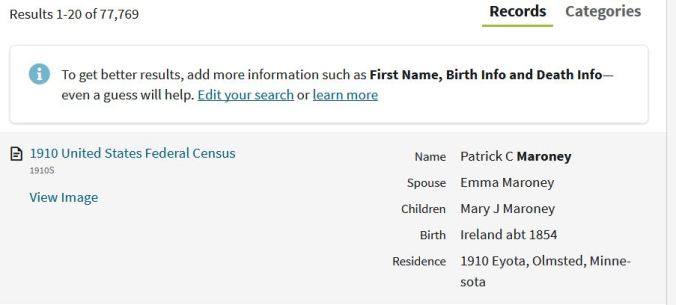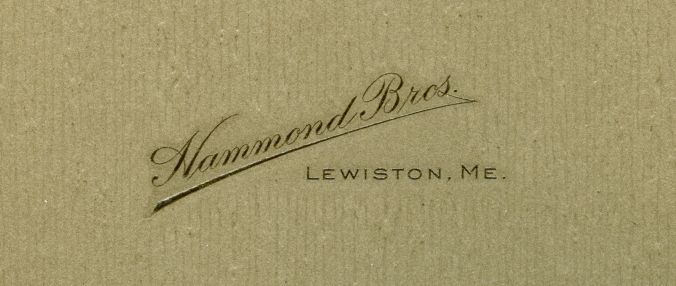Everyone knows that I love Vermont WWI material, but I also enjoy collecting photos from other New England states as well. I have a handful from every state but only one from Maine. Now I have another!
This fantastic interior studio RPPC has a ton of great qualities that drove me to make the purchase. The crossed flags at center, the helmet and pistol props, the uniform details, and the identification on the reverse all make it a great shot to add to the collection. This particular group is comprised of men from Portland and Bath.

Battery D of the 54th Artillery Regiment, C.A.C.
Identified to a Corporal Carl L. Pearson who I believe is positioned directly right of the flag, this shot shows a group of 19 soldiers posed in a French studio. This may be a record for my collection! I have a few with 6-8, but none with more than 10.
Pearson was from West Falmouth, Maine and was born in January of 1893. He enlisted with the National Guard in Portland in March of 1917 and reported for Federal service in June of that year. He was overseas from March of 1918 to March of 1919. This photo was taken in either late March, or April or May of 1918. He was promoted in early June of 1918. Since this photo shows him as a Corporal at the time of the photo, we know it was taken before his promotion. Also, his lack of OS chevron and the abundance of spats likely points towards an early photo taken in France.

A little info on the 54th CAC
Source: http://freepages.military.rootsweb.ancestry.com/~cacunithistories/54thcac.htm
WORLD WAR I — 1917 – 1919The Coast Artillery Corps a Maine National Guard were mobilized on 25 July, 1917, and all companies, band, field officers, and non-commissioner staff officers reported on 27 July. 14 staff officers reported at Portland Coast Defenses and were assigned to duty in the Coast Defenses. The several companies were re-designated at once. This designation was changed again on 23 August 1917, and on 25 December 1917, nine of the thirteen C.A.C. Maine National Guard companies were made a part of the 54th Artillery, C.A.C., the supply company and Batteries B, D, E, and F, of the new 54th Artillery, C.A.C. 6 inch guns (Motor drawn), were entirely constituted from the nine companies Maine National Guard.
The 54th Artillery, C.A.C., was organized with a Headquarters Company, a supply company, and three battalions of two batteries each. Of the 6 batteries, four were taken from the Maine National Guard and from 25 December 1917, the further World War history of the C.A.C. Maine National Guard is properly that of the 54th Artillery since over 62 percent of its units were entirely Maine National Guard. In addition, only 30 percent of the units of the Maine National Guard were not included in the organization of the 54th Artillery C.A.C.
The 54th Artillery, CAC, (6-Inch Guns, Motor)
This regiment was organized in Portland Harbor Forts on 25 December 1917, five of its units being formed from National Guard units and three from Regular Army units.
The batteries of the 54th Artillery were organized as follows:
Headquarters Company, and Batteries A and C from the Regular Army.
Supply Company, from 20th Company, Lewiston.
Battery B, from 4th Company, Portland, and 7th Company, Biddeford.
Battery D, from 2nd Company, Portland, and 4th Company, Bath.
Battery E, from 3rd Company, Auburn, and 3rd Company, Kennebunk.
Battery F, from 9th Company, Lewiston and 11th Company, Portland.
Headquarters Company, Batteries C, D, E, and F, sailed from Portland, Maine, on the CANADA, 22 March 1918 and arrived Glasgow, Scotland 2 April, Winchester, England 3 April, and LeHarve, France, 6 April 1918.
The Supply Company, Batteries A and B, left Portland 14 March, sailed from Hoboken 16 March, 1918 on BALTIC arrived LeHarve, France, 6 April 1918.
The 54th Artillery C.A.C. was sent to rest camp at Mailly-le-camp (Aube) and on 2 May 1918, transferred to Haussimont (Marne), as replacement regimen to Railway Artillery Reserve and Tractor Artillery Regiments. On 20 September 1918, the 54th Artillery was reorganized into three battalion stations as follows:
1st Battalion, Training Battalion (A and B Battery) Angers (Marne-et-Loire).
2nd Battalion, Tractor replacement(E and F Battery), Haussimont (Marne) Angers (Marne-et-Loire.)
3rd Battalion, Unknown.
After the Armistice the 54th Artillery was assigned to Brest, and part of the Regiment sailed 23 February 1919 on the Vedic arriving in Boston 7 March 1919. It was completely demobilized at Camp Devons by 13 March 1919.
The four companies (1st, 6th, 10th and 12th) that were not formed into the 54th Artillery, C.A.C. were demobilized in January 1919 at Harbor Defenses of Portland however, but few of the original members of the companies remained in them late in 1918. Two large transfers of enlisted men from these batteries were made. The first was made on 23 August 1917, to the 26th Division Artillery and Engineers. One hundred-sixty-nine men were taken from these four companies in the transfer. On May 31 1918, the other large transfer was made to the 72d Artillery, C.A.C. From the 1st Company, 147 men were taken, and from the other three companies large numbers. However, the transfers were made as individuals no units being reformed or discontinued.
In July 1922, the regiment was reorganized and designated as the First Coast Defense Command, C.A.C., Maine National Guard. The regiment was formed into Headquarters, Headquarters Detachment, Band, Medical Detachment and 1st Fort Command.
1st Fort Command
301st Company, Portland, org. 1803 – later Btry A
306th Company, Sanford, org. 1903 – later Btry B
307th Company, Brunswick, org. 1884 – later Btry C
311th Company, Portland, org. 1807 – later Btry D
2nd Fort Command
303d Company, Camden, org. 1920 – later Btry E
304th Company, Thomaston, org. 1921 – later Btry F
305th Company, Rockland, org. 1921 – later Btry G
302d Company, Vinalhaven, org. 1921 – later Btry H
On 17 September 1923, the 1st C.D.C. was re-designated as the 240th Artillery, C.A.C., and individual batteries as shown above. The designation was again changed to 240th Coast Artillery, Harbor Defense, on 16 April 1924.



































